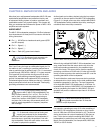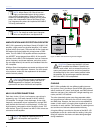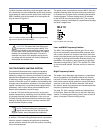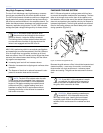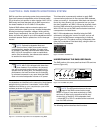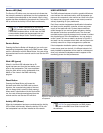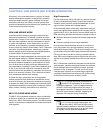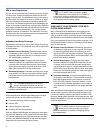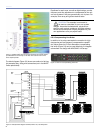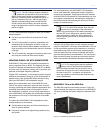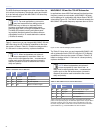
19
CHAPTER 5
A line array, in the most basic sense, is a group of closely
spaced loudspeakers arrayed in a straight line, operating
with equal amplitude and in phase. Although line arrays
have been used since the 1950s, line array systems that
provide full-bandwidth precise directivity are relatively new
to the sound reinforcement industry.
HOW LINE ARRAYS WORK
Line arrays achieve directivity through constructive and
destructive interference. For example, consider one loud-
speaker with a single 12-inch cone radiator in an enclosure.
We know from experience that this loudspeaker’s directiv-
ity varies with frequency: At low frequencies it is omnidi-
rectional; as the frequency increases (wavelength grows
shorter), directivity narrows. Above about 2 kHz, it becomes
too beamy for most applications, which is why practical
system designs employ crossovers and multiple elements
to achieve directivity across the audio band.
Stacking two of these loudspeakers and driving both with
the same signal results in a different radiation pattern. At
common points on-axis, there is constructive interference,
and sound pressure increases by 6 dB relative to a single
unit. At other points off-axis, path length differences pro-
duce cancellation, resulting in a lower sound pressure level.
In fact, if you drive both units with a sine wave, there will
be points where the cancellation is complete, which can be
shown in an anechoic chamber. This is destructive interfer-
ence, sometimes referred to as combing.
A typical line array comprises a line of loudspeakers
carefully spaced so that constructive interference occurs
on-axis of the array, and destructive interference (combing)
is aimed to the sides. While combing has traditionally been
considered undesirable, line arrays use combing to positive
effect: without combing, there would be no directivity.
MILO 120 CURVILINEAR ARRAY
The MILO 120 loudspeaker employs a unique combination
of drivers to enable you to optimize both coverage and di-
rectivity in a MILO 120 line array system. To achieve optimal
results, it’s important to understand how these components
work together.
High Frequencies
For high frequencies, MILO 120 uses very precise constant-
Q horns, developed using Meyer Sound’s own anechoic
chamber, which provide a consistent beamwidth of cover-
age in both the vertical and horizontal planes.
In the horizontal pattern of the array, these horns work just
as any wave guide does to produce wide coverage 120 de-
grees for MILO 120; in the vertical, however, Meyer Sound’s
REM technology provides semi-narrow coverage in order to:
■ Minimize destructive interference between adjacent ele-
ments
■ Promote coupling to throw longer distances
As more and more elements are arrayed in a vertical col-
umn, they project mid- and high-frequency energy more
effectively through coupling. The amount of energy can then
be controlled using the relative splay between the elements.
Curving a line array can aid in covering a broader vertical
area, while narrow angles provide a longer throw and cover-
age that more closely matches that of the mid-low frequen-
cies.
MILO 120 has been specifically designed to achieve wider
vertical angles, therefore the angles between the cabinets
should be larger than conventional line arrays, optimally
between 13 and 19 degrees. This will give a very broad
coverage area. However, due to these larger angles the
coupling will be affected and the throw will not be as long
as with other line arrays such as MILO or M3D.
NOTE: Optimal acoustical performance for
the MILO 120 loudspeaker is achieved by us-
ing angles of between 13 and 19 degrees between
cabinets. Avoid using angles outside this range. If
the angles are less than 13 degrees, too much inter-
action will occur between cabinets, degrading the
response of the system at high frequencies.
NOTE: Due to the larger splay angles, the
use of the MILO 120-I insert is highly recom-
mended between cabinets to allow MILO and MILO
120 cabinets in the same array to be fed with identi-
cal signals, with no additional equalization.
CHAPTER 5: LINE ARRAYS AND SYSTEM INTEGRATION



